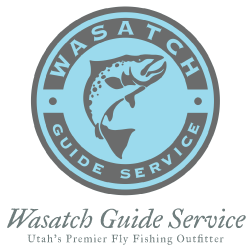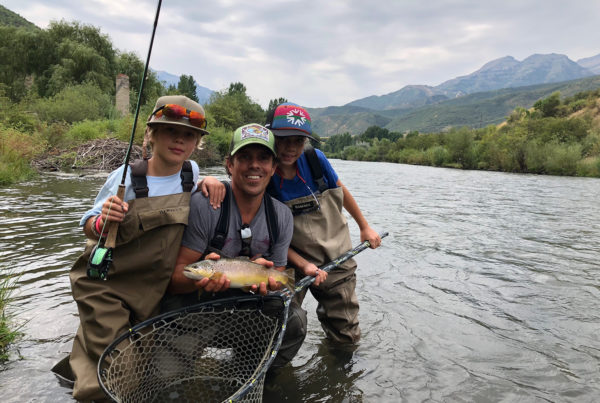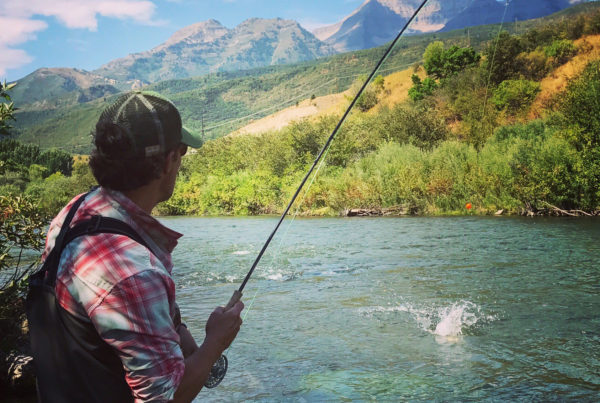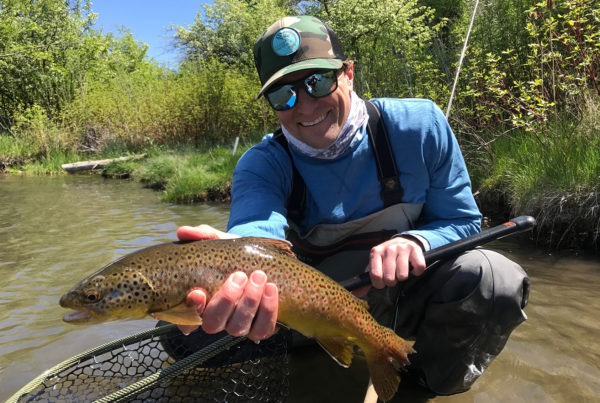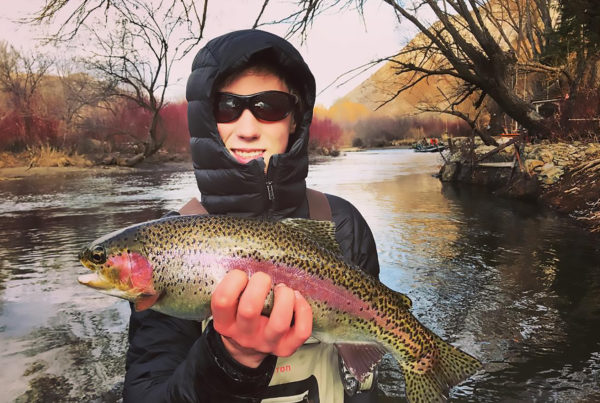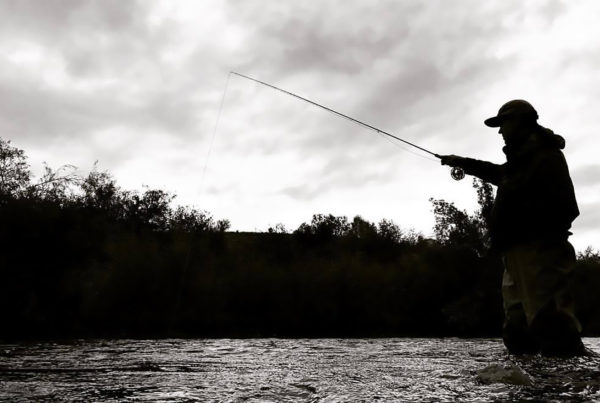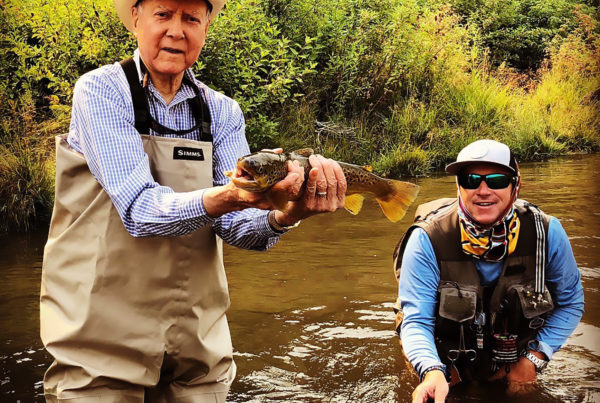A Season of Opportunity
As gear, clothing, and access have improved over the years, fly fishing has become more of a four seasons sport. Many of the access points we fish during the winter were inaccessible to anglers 20 years ago. Today’s younger generation of anglers doesn’t even realize that in years past there used to be an actual fishing season that ran from spring to fall.
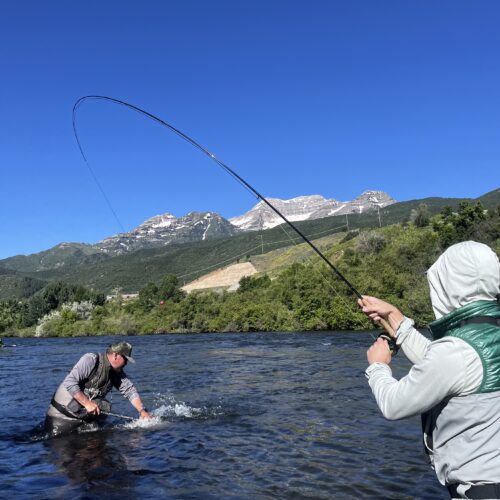
Utah Spring Fisheries
As is the case with most fisheries in winter, tailwaters are the playgrounds of anglers in the spring. Because snow still covers much of the ground and water temperatures are still cold, most freestone rivers and backcountry/small streams are locked up in ice or. Another issue anglers have to contend with later in spring is higher, muddy water as a result of snowmelt and spring runoff. Freestone streams usually experience the biggest impact from runoff since freestone streams are upstream of the reservoirs. This means they are much more vulnerable to siltation once runoff begins. Because dam managers usually allow water levels to rise significantly before raising flows out of the dams, this makes for a later runoff. Your typical popular northern Utah fisheries offer the best fishing in the spring. The Lower Provo and Middle Provo, Weber, Ogden, and Green Rivers offer the best spring fishing in the area.
Spring Fly fishing Techniques
One of the biggest keys to being a successful angler is the ability to adapt to changing techniques, and spring is no different. One of the main misconceptions many anglers have is that spring, (especially early spring) is still cold so dredging the bottom with nymphs must be the only way to catch fish during this time of year. That couldn’t be further from the truth! One of the most exciting things about fishing during this timeframe is the spectacular dry fly fishing.
You can literally set your clock to the consistency of the fishing during this time of year. Early mornings are the slowest fishing of the day. With the least insect activity and colder temps, the fish are less active. As the day progresses and the weather and water warms, insects become more active as do the fish. Although dry fly fishing typically hasn’t turned on yet, the plethora of midge pupa and active baetis nymphs has the fish on the feed subsurface by 10:30 AM. Strike indicator nymphing is very effective during this time, but not the only way to catch fish subsurface. Dry/dropper and suspended nymphing setups can be as effective as the heavy stuff, and a lot more fun to fish. Once the warmest part of the day hits the dry fly fishing gets going in earnest. Typically the peak of dry fly fishing will be from 12:30 to 3:00. There will be Blue Wing Olives coming off and fish can frequently be found rising just about everywhere. The bugs are small (#18-20) and numerous so the fish can be a little selective about presentation and drift. Long leaders and light tippets are the rule. Down and across slack line presentations will be much more successful than casting directly upstream or up and across.
Utah Spring Hatches
As stated above, the premier hatch of spring is the Blue Wing Olive (BWO), also known as baetis. Baetis are small grayish olive mayflies that run from a size 16 to size 22. Blue wings start around the last week of February and run into May, once runoff shuts them down. The peak of the hatch is usually from March 15th to April 15th. Generally, the bugs are bigger in size earlier in the season and gradually get smaller and smaller towards the end. As with most mayflies, cloudy moist days usually make the best hatch conditions. Damp, cold weather causes the insects to float on the surface longer because their wings take longer to dry before they fly away.
As mentioned previously, midges are also an Generally, the adults begin to hatch about an hour before the baetis (between 11:00 and noon), although the pupa are active and in the drift throughout most of the day.
Another insect that hatches during this time of the year and dwarfs the others in size, yet is not as well known is the Skwala Stonefly. Most adult skwalas average in size from a #10 to #12, massive compared to bwo’s and midges! Like most other stoneflies, these insects hatch on land and end up landing in the water during egg laying or during their clumsy flight. These bugs are most active on warm days from mid-March to mid-April. Throwing larger stonefly dries tight to the bank with lots of overhanging foliage can yield an occasional big fish on those bright days when the blue wings just don’t seem to come off in full force.
Utah Spring Fishing “Happy Hour”
While most anglers associate spring fly fishing as a bankers hours event, that is not always the case. Even though most anglers have reeled in and called it a day before 4:00, there’s another dry fly fishing event later in the evening for those who are willing to stay out a little later and bring a headlamp. As afternoon turns to evening, many of the hatched midges from the previous day come back to the water to make and lay their eggs. On clear, warm evenings, the evening midge fishing can often times be better than the BWO dry fly fishing earlier in the day. There are several factors that combine to make this happen. First, the fish have lost their timid nature from earlier in the day as a result of lower light and very few anglers. Often times, the fish are in only 6-8 inches of water and you can sneak to within 10 to 15 feet before placing your cast. Second, these fish are much less pattern selective than they are during the middle of the day. The same fish that is discerning towards exact #20 and #22 mayfly imitations during the middle of the day will readily rise to a #14 Parachute Adams on 4X in the evening. On the lower Provo, Rainbows are notoriously difficult to get on dry flies during the middle of the day. Yet, the same stretches of water that produced only browns earlier will have pods of rainbows eating the mats of mating midges. The rewards are well worth staying out into cold evening fishing until dark. Having the river all to yourself is definitely the icing on the cake.
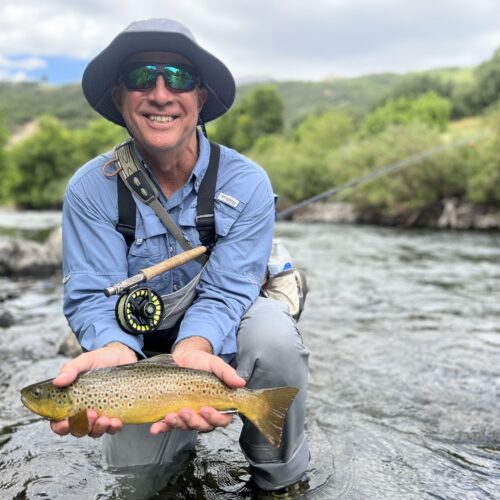
Utah Summer Fisheries & Fish
Summer is without a doubt the most exciting and most diverse time to fish here in Northern Utah. Not only is the fishing incredibly good and consistent, but also there are a plethora of waters to fish. We may not have large, famous rivers (other than the Green River of course), but we do have a myriad of small remote streams to explore. The streams may be smaller to medium sized, but that doesn’t mean that they don’t hold large fish. Quite the contrary, they hold numerous species of trout that can grow to be as large as fish in rivers 20 times their size.
Brown Trout are still the most prominent species found in smaller streams throughout Utah, numerous other species are also present. Rainbow and Cutthroat trout are also common, as well as Brook Trout, Mountain Whitefish, Tiger Trout (brown/brook trout hybrid), Splake (brook/lake trout hybrid), and even Arctic Grayling. The upper stretch of the Provo and Weber rivers, as well as the South Fork of the Ogden River contain all of these species and it is realistic to get a super slam (all species landed in the same day) on many of these waters. Some of the better remote waters in northern Utah are Currant Creek, Strawberry River, Ogden River, Blacksmith’s Fork, Logan River, Diamond Fork, Duchesne River, American Fork Creek, Thistle Creek, Bear River, Fish Creek, and Rock Creek. These streams range in size from a moderate leap to cross, to 40 feet or so across. Many of these streams are freestone rivers that drain large expanses of high elevation terrain. Combine a long runoff period and difficult access in the winter and you see why summer is when these streams shine. Utah’s rivers and streams produce some of the best fishing you will find anywhere when many rivers in other areas are plagued with warm water, lethargic fish, and flotillas of rafters.
Utah Summer Fly Fishing Seasonal Progression & Techniques
Early Summer High Water Fishing
Summer is like having several seasons rolled into one. Summer starts on most rivers with lots of cold, dirty water running off out of the mountains. Runoff on most normal water years starts in mid-late May and usually lasts into late June, but on very wet years, runoff can continue well into July. Runoff does not always mean that fishing is futile, but you definitely have to adapt and adjust techniques to meet the conditions. Many of the rivers we fish are tailwaters (rivers flowing from a dam). Tailwaters not only regulate water temperatures, but the impoundments above collect all the dirty water coming down from the mountains and keep the water clearer than freestone rivers, even during extremely high flows.
During runoff you can encounter some interesting scenarios including higher water washing all sorts of land-based insects into the river. Various types of worm species make up the majority of this annelid “hatch.” The stronger flows will also push fish tighter to the bank where they can conserve their energy. This sets up an ideal situation for very productive nymph fishing. It may not be graceful, but fishing down deep in secondary holding water with worm imitations during high water can yield some of the highest catch rates of the entire year. Needless to say, the San Juan Worm is one of the most important flies to have in your fly box in early summer.
Mid Summer Dry Fly Fishing
As the waters of runoff recede, this gives way to the best insect hatches of the year. Hatches can be as varied as they are intense. Pale Morning Dun and Green Drake mayflies; various Caddis; Golden, Yellow Sally Stoneflies; Salmon flies, and certain types of terrestrials (such as cicadas) can all be found in huge numbers in early to mid summer. Nymphing as usual is highly productive, but this is the time for dry fly fishing. On tailwaters where mayflies and caddis dominate, classic hatch-matching techniques will be successful. Working on slack line presentations and down and across presentation casts will yield the best results. Fish in heavily fished tailwaters such as the Provo River have dry flies drifted across their nose every day. Covering the water with big bushy attractors will yield lots of spooked fish in these places. Scaling down fly size, tossing more exact imitations, and working individual fish will ensure that your fly spends more time in a fish’s mouth than in the bushes.
As July gives way to August, caddis take the place of mayflies and stoneflies in the hierarchy of trout food importance. Because caddis are more active early and late in the day, it becomes more important to get on the water before the sun does and head back to the truck well after evening has given way to night. August nights are the season of headlamps and the sound of large brown trout gulping mats of mating caddis into the darkness. While summer mornings and evenings are the marquee times for hatch fishing, there are still plenty of dry fly opportunities to be had throughout the day.
Late Summer Terrestrial Fishing
As summer progresses, terrestrial (land based insects) become more and more active and abundant. Any angler, who has had a very large fish smash a big foam hopper in water barely deep enough to cover their wading boots, will testify that few things in the sport of fly fishing can be as exciting.
Utah is an arid state with a dry climate that creates an ideal habitat for numerous terrestrial insects such as grasshoppers, ants, cicadas, etc. On many of the smaller northern Utah streams, these insects make up the bulk of the food source for most of the fish. One of the biggest mistakes that many fly fishermen make when fishing big terrestrials is fishing too light of a tippet. Bulky, wind resistant flies need a stiff, heavier leader to effectively turn the flies over. Fish feeding on these insects are feeding opportunistically. Rarely, if ever, are they going to shun a large, rubber legged foam hopper imitation because of the tippet. Switching from 4 or 5X tippet down to 2 or 3X will give you the necessary stiffness to turn over the fly and present it correctly. The endless twisting of light tippet causes endless rat’s nests and weakens the line. A strong, stiff leader will stand up to line abrasion consistent with fishing flies tight to the banks as well as hold strong when a big fish makes a run into the cover that he just dove into.
A season of opportunity
As gear, clothing, and access have improved over the years, fly fishing has become more of a four seasons sport. Many of the access points we fish during the winter were inaccessible to anglers 20 years ago. Today’s younger generation of anglers doesn’t even realize that in years past there used to be an actual fishing season that ran from spring to fall. This doesn’t change that fact that we, as anglers, still stew in anticipation of the summer fishing season. It never seems to get here soon enough and passes us by sooner than we would like every year since summer is the season of opportunity. Utah offers us so much for diversity and many of those options are only available in the summer. Snow blankets the backcountry for much of the year. So our best piece of advice for fishing during the summer months is to get out and fish as often as you can and as much as you can. Utah is a fantastic destination for anglers and summer allows you the best time to sample all of those flavors while they are at their peak.
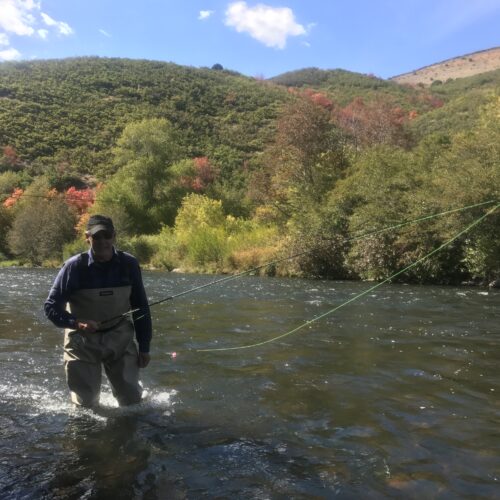
Utah Fall fisheries
Because winter doesn’t usually take hold until mid-November, many of the mid to high elevation streams are still readily accessible during the months of September, October, and into November. September is a magical month if you like to fish in solitude. Kids are back in school, most vacationers have left for the summer, and many local sportsmen have traded the fly rod in favor of rifles, shotguns, and bows. As a result, while many sportsmen are storming the hills in search of deer, elk, grouse, etc., you can get opportunities to chase massive fish with nobody else in sight.
Brown Trout and Brook Trout are both fall spawners so this is the time when the aggressive nature of both of these fish peak. Brown Trout are the dominant species in Utah and the Weber, Provo, Green, Strawberry, Logan, Diamond Fork, Duchesne, Ogden, Price, and Sevier rivers all have the potential to grow trophy sized Brown Trout. Because of their aggressive spawning behavior, fall is the prime time to target these monsters. When targeting big fish, keep in mind their habits during the fall season and focus your efforts on strategically selected areas. Stretches of rivers immediately upstream of lakes are a prime place to start your search as many fish move out of the Stillwater into moving water to spawn.
Many of the higher elevation lakes in Utah contain brook trout or “brookies”. The Uinta Mountains are a great place to start since this range has over 1,000 lakes, of which somewhere around 600 hold trout. Brook trout are the predominant species here and with the sheer amount of lakes, several can be fished in the same day. Down in the southern portion of the state, there are also numerous high elevation plateaus in which Brook Trout thrive. Because various factors such as food source, elevation, lack of winter kill, etc., these lakes (most specifically Thousand Lakes Mountain and the Boulder Mountains) grow immense Brook Trout. Some of the largest brookies in the country can be found here.
Utah Fall Hatches
For the most part, the sizes of insects during fall are usually much smaller than their summer counterparts. The primary hatches during the fall season are caddis, Blue Wing Olives (baetis), Pale Morning Duns (PMDs), and midges. There are actually two subspecies of PMDs you will encounter. Ephemerella Inermis and Ephemerella Infrequens are their latin names, but all an angler needs to know is that the smaller ones are most common in the fall. These smaller PMDs are usually a size 18 -22 with coloration more of a pale cream with a slight olive tint. These late season PMDs are most common from early September through late October. When flow regimes out of Jordanelle Reservoir are higher through the summer, PMDs hold off from hatching throughout much of the summer months. Once these flows are dropped, typically around early September, this triggers massive amounts of PMDs to hatch all at once throughout the month of September, offering far and away the best dry fly fishing of the year.
As PMDs fade away as fall progresses, fall Blue Wing Olives (baetis) begin to take their place. The presence of these mayflies is much more important on tailwater fisheries as opposed to freestone streams. Many anglers use the term pseudocloeon or “pseudo” for short. These mayflies are tiny, averaging in size from #20 to #24, although much smaller at times. For what they lack is size, they make up for in numbers. Some rivers such as the Green and the Provo, these hatches can be so thick that they form solid mats of insects on some windblown eddies.
Of course the early part of fall is also a great time for terrestrial fishing. Grasshoppers are at their highest numbers at this time and a myriad of other terrestrial insects is also available.
Fall Fishing Techniques
One of the great things about fishing in the fall is that all techniques of fly fishing are effective. Whether you enjoy big or small dry fly fishing, hopper-dropper fishing, nymphing, streamer fishing, or swinging soft hackles, all can and will produce during the autumn months.
Fall Streamer Fishing
Streamer fishing is a favorite of many fly fishermen during fall as spawning behavior can bring out the aggressive nature of brown trout. As Browns enter their pre-spawn stage, they become very territorial and willing to attack almost anything that comes close to their position. While old school patterns such as mickey finns, woolley buggers, matukas, and muddler minnows have caught countless fish over the years and are still very effective; there are many more modern flies that will do a better job enticing strikes from predatory fish. With various types of flash, built in articulation, dumbbell/tungsten heads, and extensive use of synthetics and natural materials that move well in the water, these modern streamers are almost irresistible to big fish.
The biggest key to effective streamer fishing is to change up the retrieve. Strip fast, slow, erratic, and everything in between until you find what the fish respond to best. The best streamer fishing coincides with the window in between summer hatches ending and fall hatches starting up.
Fall Dry Fly Fishing
Until the first couple hard freezes of the year, terrestrial fishing is still usually fantastic. Fish are very opportunistic at this point and will respond to a variety of terrestrials such as hoppers, crickets, ants, beetles, etc.. Fishing a beadhead dropper can be highly effective at this time, but a dropper can make it more difficult to fish your fly tight to the bank so keep this in mind. If fish are very tight to cover and surface oriented, then cut the dropper off and you can fish your dry fly more effectively.
Fall Nymph Fishing: To egg or not to egg?
There is no doubt that egg patterns are the most effective way to catch fish once actual spawning takes place. Some anglers are all for it and some are very much against it and it is basically up to you whether you choose to fish with egg patterns. The biggest problem with fishing during the spawn is many anglers inadvertently step on “redds”, or spawning beds. As an angler you can ethically fish during the spawn if you use certain precautions. Number one, ALWAYS watch where your feet are. Redds can be identified as patches of lighter colored gravel dug down lower than the stream bottom surrounding it. If you are to step on one of these places, in all likeliness you will be crushing thousands of eggs. Also, it is best to try and avoid actively spawning fish so that they can repopulate the stream, so aim your efforts in other areas.
Fishing Beads
As far as setup goes, it is hard to beat the Alaskan style bead rigs during the spawn. These are built by securing an egg colored bead an inch or two above a larger scud hook and fishing it like a regular nymph rig. Beads usually outfish classic yarn eggs by at least 2 to 1, sometimes more. There are several advantages:
1. Beads have a perfectly round silhouette, just like the real thing.
2. It is much easier to match the color of the bead to the real thing.
3. A larger hook away from the bead holds much better.
4. Heavier tippet allows a faster release of fish. Our personal favorite is Maxima in #6 to #10 lb. it is stiff and very abrasion resistant.
Whatever fly fishing method you choose, there is some awesome fall fishing to be had in Utah. Get out there and take advantage of it and have a great time!
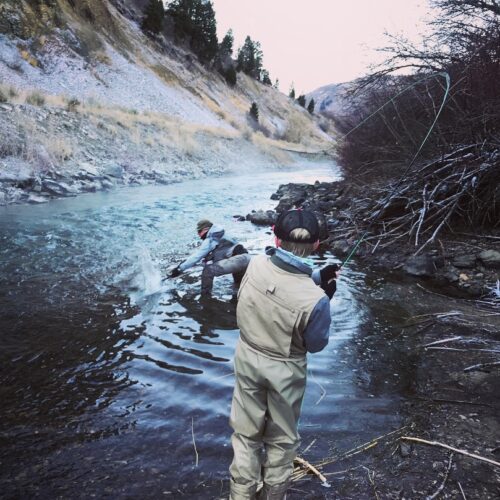
Tailwater Fisheries
Many of our local Utah rivers are tailwaters (rivers that flow from a man made dam). Because of this, the water temperature in these rivers tends to be more constant throughout the year with less fluctuation and as a result the water temperature is typically warmer than non dammed rivers. Because trout activity is higher when the water temperature is warmer, the winter fishing on these tailwater rivers can be quite good. In fact, there are times when the fishing in the winter rivals the fishing of any other time of the year. Our primary local rivers, the lower Provo River, Middle Provo River and Weber River are all tailwater fisheries and where we focus most of our efforts during the winter months.
Winter Fly Fishing Techniques
Like most times of the year, trout feeding in the winter is largely dominated by subsurface feeding and as a result much of the winter fly fishing we do is strike indicator nymphing. However, there are opportunities to dry fly fish to rising fish on the surface, and occasionally we might throw a streamer to try and entice a trophy. It largely depends on the conditions we encounter each day and the ability of the angler. One common characteristic of winter fly fishing is that unlike many other times of the year, the fish tend to school up and concentrate in the slower, deeper pools where they can conserve energy so if you find them you can frequently catch several fish.
Winter Nymph Fly Fishing
Far and above the most productive method of winter fly fishing (and any time of the year for that matter) is strike indicator nymphing. Being that the fish are concentrated in the slower deeper pools and runs during this time of the year, this is where they do most of their feeding. Because this is where the trout are hanging out and feeding, nymphing is the best way to catch them. Frequently during the winter the fish can key on very small nymphs, but our guides have you covered with their own special patterns to imitate these smaller food sources.
Winter Dry Fly Fishing
On many winter days, especially toward late January through spring, midges can hatch in large numbers and the fish can be found rising to them in the slower edges and seams. It is during these times that the winter fly fishing is in its true glory since it doesn’t get much better than large rising trout on a crisp clear winter day with the river all to yourself. This type of fishing isn’t easy though since midges are quite small. The flies to imitate them are also very small and can be difficult to see and drift correctly. Our guides are well versed in tracking small flies and have specialized fly patterns that are easier to see to help you fool those large rising brown trout.
Winter Fly Fishing Solitude
A peaceful, sunny winter day on the water with the river all to yourself can be an incredibly relaxing experience. Winter fly fishing is a great way to get rid of cabin fever and enjoy some fresh air and excitement of catching a few trout. If you haven’t tried winter fly fishing before or you have and haven’t been for a while take a trip with us and let us show you what a great time awaits you on the rivers in winter. A few days of skiing or snowboarding have your legs worn out? Take an afternoon winter fly fishing trip with us, it will be an experience you won’t soon forget.

